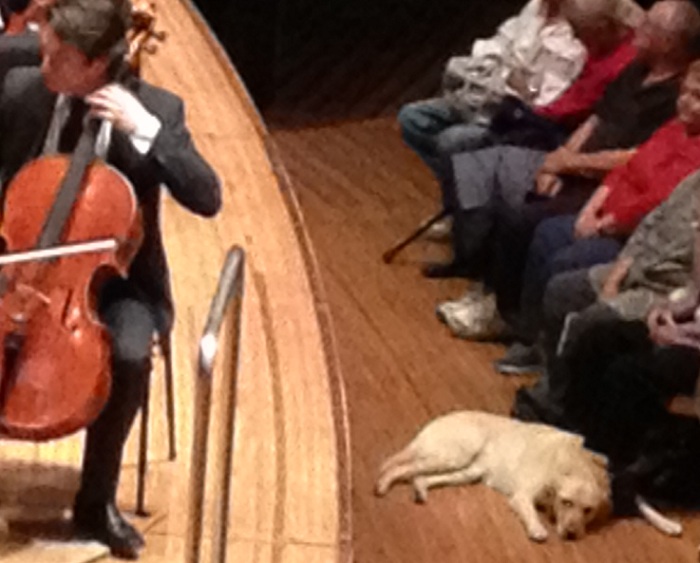
W ithout doubt, there is something you are doing profoundly right in your interpretation as a soloist when a yellow Labrador retriever in Row 1 listens attentively, head raised and up on her/his elbows, throughout your Beethoven concerto performance. (I do not know whether the same holds true of cats, except possibly Siamese—a point about which Christopher O’Riley and other cat-owning pianists may be able to comment.) Labradors are kindly, good-natured, and take a lot of things in stride. As a breed, the Labrador is notable for being steady-tempered but does display impatience with human pretension in all its manifestations. If she finds your expressions burdensome, the Labrador will sigh or adjust her posture, clunking her bony forearms on the wood floor loudly. But Andreas Haefliger’s account of Beethoven’s second piano concerto was true enough, and the Labrador looked thoroughly pleased as Andreas took his bows. We were well pleased too. (The probity of the cellos was periodically a matter of some doubt, though.)

T his concerto offers many dramatic moments—some Mozartian figures; some prodigious cadenzas that Beethoven only wrote down when the piano part was published in 1809, because up until that time he used the piece as a promotional vehicle for his own career as a concert pianist and did not wish other pianists to co-opt the work or eclipse him. And in that regard the interaction in this concerto between the soloist and the ensemble has been the subject of considerable scholarly writing—some authors opining that Beethoven had not by the early date of this concerto’s birth yet mastered the composerly skills of constructing the arcs that define soloist-orchestra narrative.
B ut Haefliger takes this material and masterfully does with it what can only be viewed as authentic completion of Beethoven’s meaning and intent. He knows how to take the measure of the concertmaster and first violins behind him, and gaze at the oboes as they speak, and then deliver his own lines in a manner that the others accept as truthful—an honest account to which they must respond in-kind. The brass, characters not known for tender sensibilities, wait for the completion of Haefliger’s pianissimo figure, a deep contemplation evident in the piano’s right hand, and are made visibly more humane and introspective by it. Haefliger finishes a burst of activity, leans backward, left hand falling to his side, right hand rising in a flourish, and looks earnestly to his left at the orchestra to see what their answer will be. He imparts a magisterial, conductorly relish to the meaning; to use a cinematic or theatrical phrase, he ‘pulls focus’ beautifully onto and off of himself in a way that makes the ‘character’ of the solo part believable and engaging and which enhances the overall flow of the story, including the part of it that belongs to the ensemble to tell.
T he cadenza was full of bravado; the recitative passages, aptly confessional. When the tempo is slow enough, the shorter notes were played softer, without loss of clarity... which, as I understand, is a ‘bebung’ clavichord technique that Beethoven sometimes used in his piano writing for dramatic expressive purposes. In fact, the whole performance yesterday embodied the best qualities of excellent drama and interplay between soloist and orchestra. Bravo!

I was consumed with sheer terror. How, how, how? How does this start? The silence lengthened, ominously. When you’re on-stage, a few seconds of silence feels like an eternity. This was considerably more than a few seconds, and I felt it pressing down on my shoulders. Finally, in panic, I had an idea: maybe if I just put my fingers up on the keyboard, they’d know what to do. I lifted my hands slowly to the keyboard. The audience was surely, by this point, deeply impressed. And, by a miracle, it worked. By themselves, on their own, my fingers found the right configuration of black and white keys, and I let them go. Before I knew it, they had jumped into the opening theme [of the third movement of Op. 19], and the orchestra soon came galloping up behind them.”
— Leon Fleisher, p. 24.
- Andreas Haefliger website
- Focus-pulling page at Wikipedia
- Follow-focus page at Wikipedia
- Rack-focus page at Wikipedia
- Nagib L. World Cinema and the Ethics of Realism. Continuum, 2011.
- Stadler J. Pulling Focus: Intersubjective Experience, Narrative Film, and Ethics. Continuum, 2008.
- Fleisher L, Midgette A. My Nine Lives: A Musical Memoir. Anchor, 2011. (pp. 21-23 are about Fleisher’s experiences with cadenzas in Beethoven’s Cto. No. 2, Op. 19)
- Beethoven Piano Concerto No. 2, Op. 19, in B-flat score at IMSLP.org
- HotDocs 2012 (Canadian International Documentary Film Festival)
- Labrador retriever page at AKC.org
- DogTime.com
- Sydney Opera House website

No comments:
Post a Comment